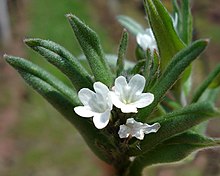
Chenopodium is a genus of numerous species of perennial or annual herbaceous flowering plants known as the goosefoot, which occur almost anywhere in the world. It is placed in the family Amaranthaceae in the APG II system; older classification systems, notably the widely used Cronquist system, separate it and its relatives as Chenopodiaceae, but this leaves the rest of the Amaranthaceae polyphyletic. However, among the Amaranthaceae, the genus Chenopodium is the namesake member of the subfamily Chenopodioideae.
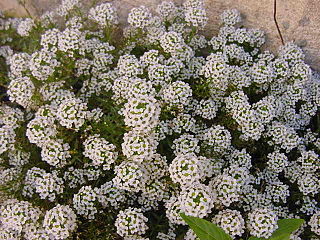
Lobularia is a genus of five species of flowering plants in the family Brassicaceae, closely related to the genus Alyssum. The genus is native to Macaronesia and the Mediterranean region, and comprises annuals and perennials growing to 10–40 cm (4–16 in) tall, with hairy oblong-oval leaves and clusters of cross-shaped (cruciform), fragrant white flowers.

Lithospermum is a genus of plants belonging to the family Boraginaceae. The genus is distributed nearly worldwide, but most are native to the Americas and the center of diversity is in the southwestern United States and Mexico. Species are known generally as gromwells or stoneseeds.

Silene dioica, known as red campion and red catchfly, is a herbaceous flowering plant in the family Caryophyllaceae, native throughout central, western and northern Europe, and locally in southern Europe. It has been introduced in Iceland, Canada, the US, and Argentina.
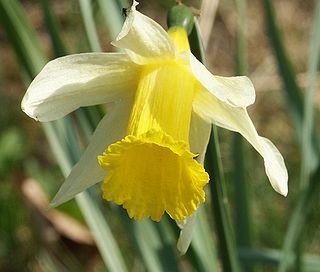
Narcissus pseudonarcissus, commonly named the wild daffodil or Lent lily, is a perennial flowering plant.

Lithospermum arvense, known as field gromwell, corn gromwell, bastard alkanet, and stone seed, is a flowering plant of the family Boraginaceae. It is native to Europe and Asia, as far north as Korea, Japan and Russia, and as far south as Afghanistan and northern Pakistan. [1] It is known in other places as an introduced species, including much of North America and Australia. [2],[3] The European Union has granted the refined oil of the seed of Buglossoides arvensis novel food status and some farmers are growing it [4] commercially in the United Kingdom as a plant-variety patented (PVP) and trademarked cultivar (Ahiflower®). The seed oil contains high levels (63-72%) of omega-3 ALA (c18:3), omega-3 SDA (c18:4), and omega-6 GLA (c18:3)[5] and has GRAS review status from the US Food and Drug Administration, Canadian ingredient master file (IMF) registration and novel food status, and GMP+ Feed Support Product status in the EU for livestock and companion animals. The seed oil also has TGA Australia Complementary Medicines approval status, ANVISA/MAPA Brazil human and animal alimentary use approval, and limited food use approvals in Korea and Japan.

Lithospermum officinale, or common gromwell or European stoneseed, is a flowering plant species in the family Boraginaceae, native to Eurasia. It is the host plant for caterpillars of the monophagous moth Ethmia dodecea.

Sanicula epipactis is a species of flowering plant of the family Apiaceae, native to Europe. Under the synonym Hacquetia epipactis, it was the only species in the monotypic genus Hacquetia.

Glandora diffusa, the purple gromwell, syn. Lithodora diffusa, Lithospermum diffusa, is a species of flowering plant in the family Boraginaceae. It is a mat-forming perennial growing to 15 cm (6 in) tall by 60 cm (24 in) or more wide, with dark green, hairy evergreen leaves and masses of blue or white 5-lobed flowers. It is suitable for cultivation in a rock garden or alpine garden.

Lithospermum incisum is a species of flowering plant in the borage family known by several common names, including fringed puccoon, narrowleaf stoneseed, fringed gromwell, narrowleaf puccoon, and plains stoneseed. It is native to much of central Canada and the United States, where it is known from many types of habitat, but particularly piñon-juniper woodland. It is a hairy perennial herb growing from a narrow brown to black taproot and woody caudex. It produces a cluster of stems up to about 30 centimeters long. The stems are lined with narrow, pointed leaves up to 6 centimeters long. The slender, trumpet-shaped flowers are pale to bright yellow or gold, and may approach 4 centimeters long. The corolla face is 1 to 2 centimeters wide, its lobes sometimes ruffled. The smaller cleistogamous (closed) flowers are the main producers of seed.

Lithospermum canescens, or the hoary puccoon is a perennial herb endemic to eastern North America. The plant grows in a variety of habitats. It has golden yellow flowers which bloom from April to May.

Lithospermum californicum is a species of flowering plant in the borage family known by the common name California stoneseed. It is native to southern Oregon and northern California, where it can be found in many types of mountain habitat, such as forest, woodland, and chaparral, sometimes on serpentine soils.
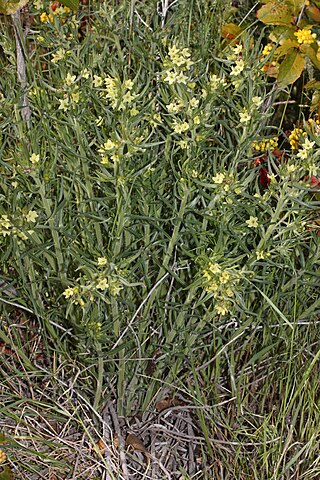
Lithospermum ruderale is a species of flowering plant in the borage family known by the common name western stoneseed or lemonweed. It is native to western Canada and the western United States, where it can be found in many types of habitat. A perennial herb growing from a taproot and woody caudex, it is covered with fine, more or less upright, hairs, especially on the stems. It produces a cluster of erect leafy stems ranging from 20 to 50 centimetres centimeters in height. The stems support lance-shaped leaves ranging from 2.5–10 cm (1–4 in) in length. Bunches of flowers with leaf-like bracts appear toward the top of the stem amongst the leaves. The corolla is fused at the base with five lobes which are light yellow, often slightly greenish, and about a centimeter long and wide. The style is short. The fruit consists of one or two, sometimes four, clustered glossy grey nutlets, 3.5 to 6, sometimes as much as 8 mm long.
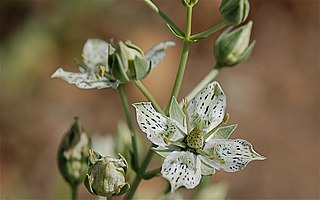
Frasera parryi is a species of flowering plant in the gentian family known by the common name Coahuila frasera.
Frasera tubulosa is a species of flowering plant in the gentian family known by the common name Kern frasera.

Lithospermum purpurocaeruleum is a synonym for Aegonychon purpurocaeruleum (L.) Holub, also known as the purple gromwell, This plant is a herbaceous perennial rhizomatous flowering plant and it belongs to the family Boraginaceae.

Lithospermum latifolium is a species of flowering plant in the borage family known by the common names American gromwell and American stoneseed. Its native range is centered in the Midwestern United States, where it is found in calcareous forests. It is a hairy, tall perennial herb that produces small yellow flowers in late spring.
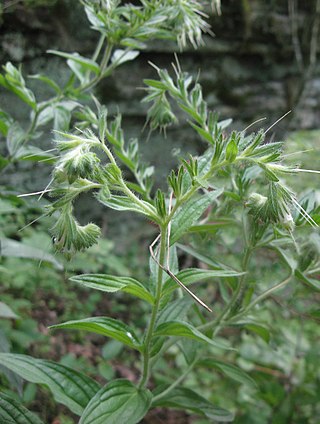
Lithospermum parviflorum, commonly called Eastern Prairie Marbleseed, is a species of flowering plant in the forget-me-not family. It is native to the eastern North America.

Clinopodium menthifolium, commonly known as the wood calamint or woodland calamint, is a species of flowering plant in the mint family, Lamiaceae. It is found throughout southern and central Europe from the United Kingdom and east as far as temperate parts of Asia, and as south as North Africa. It grows up to 1,700 m (5,600 ft) in elevation.
